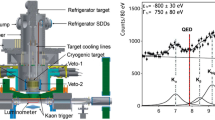Abstract
The scientific program and the experimental setup of the DEAR (DAΦNE Exotic Atom Research) experiment at the new φ-factory DAΦNE of Laboratori Nazionali di Frascati are described. The objective of DEAR is to perform a 1% measurement of the K α line shift due to the strong interaction in kaonic hydrogen. A measurement will also be performed on kaonic deuterium for the first time. The aim is to investigate low-energy \(\overline K N\) physics and to understand SU(3) chiral symmetry breaking. The setup takes advantage of the unique features of the “kaon beam” from the φ decay in DAΦNE; of a low-temperature pressurized gaseous target; and of a detector for soft X-rays – the Charge-Coupled Device (CCD) – characterized by a very good energy (and spatial) resolution and by an unprecedented background rejection capability. The DEAR experiment represents a major effort in the study of low energy \(\overline K N\) interactions and has the potential to produce a breakthrough in the field.
Similar content being viewed by others
References
G. Vignola, in: Proc. of the 5th European Particle Accelerator Conf. (EPAC'96), Sitges, Barcelona, eds. S. Myres et al., Institute of Physics Publishing, Bristol/Philadelphia (1996) p. 22.
S. Deser et al., Phys. Rev. 96 (1954) 774; T.L. Truemann, Nuclear Phys. 26 (1961) 57.
G. Toker, A. Gal and J.M. Eisenberg, Nuclear Phys. A 362 (1981) 405.
M. Torres, R.H. Dalitz and A. Deloff, Phys. Lett. B 174 (1986) 213.
A. Bahoui et al., Nuclear Phys. A 508 (90) 335c.
J.F. Gunion, P.C. McNamee and M.D. Scadron, Nuclear Phys. B 123 (1977) 445.
B. Borasoy, hep-ph/9807453 (1998).
EMC Collaboration, J. Ashman et al., Nuclear Phys. B 328 (1989) 1.
E142 Collaboration, P.L. Anthony et al., Phys. Rev. D 54 (1996) 6620.
SMC Collaboration, B. Adeva et al., Phys. Rev. D 58 (1998) 112001.
J. Gasser and M.E. Sainio, Phys. Lett. B 253 (1991) 252, 260.
J. Gasser and H. Leutwyler, Phys. Rep. 87 (1982) 77; J. Gasser, Ann. Phys. (NY) 136 (1981) 62.
R.L. Jaffe and C.L. Korpa, Comments Nucl. Part. Phys. 17 (1987) 163.
J.-P. Egger, this issue.
T. Koike, T. Harada and Y. Akaishi, Phys. Rev. C 53 (1996) 79.
R. Brun et al., GEANT3, CERN Report DD/EE/84–1 (1987).
R. Baldini, C. Guaraldo et al., The DEAR proposal, LNF-95/055(IR) (1995).
S. Guiducci and M.A. Iliescu, Beam-gas background calculation for DEAR, Frascati Report LNF-97/002 (IR) (1997).
R. King, Statistical and systematic errors in the DEAR experiment, DEAR Technical Note IR-3 (1998).
Author information
Authors and Affiliations
Rights and permissions
About this article
Cite this article
Guaraldo, C., Bianco, S., Bragadireanu, A. et al. The DEAR case. Hyperfine Interactions 119, 253–261 (1999). https://doi.org/10.1023/A:1012612231176
Issue Date:
DOI: https://doi.org/10.1023/A:1012612231176




